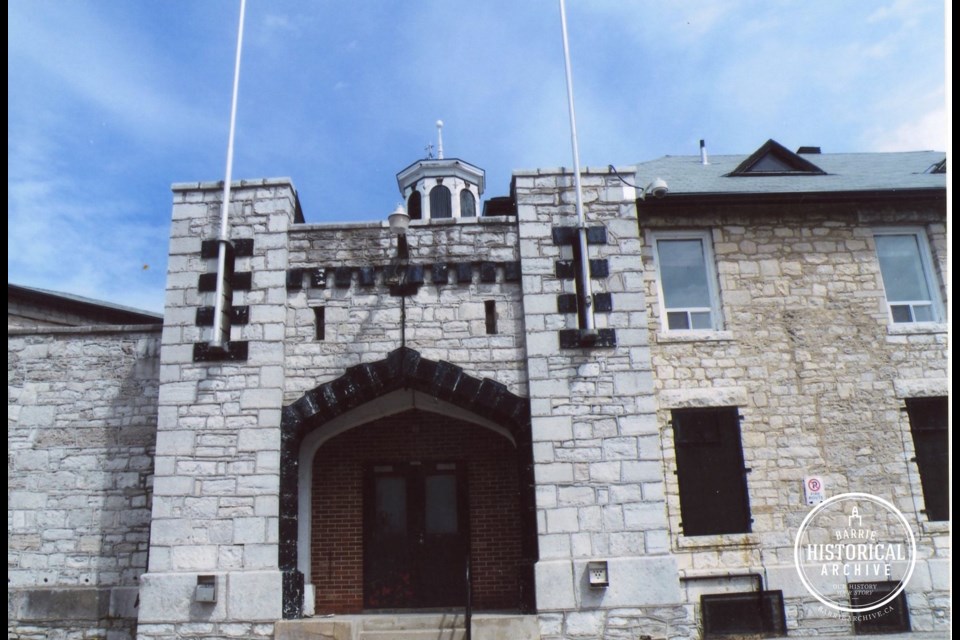Local youth Alexander Manson had long caused local law enforcement all sorts of trouble.
In early 1931, Manson was released from a two-year prison sentence. Back in Barrie for only four days, he was caught breaking into J.F. Craig’s clothing store on Dunlop Street.
Not surprisingly, Alexander Manson was given another two years for that crime.
As he sat in the Barrie lock-up awaiting transfer to Burwash Reformatory, Manson made friends with Leslie McLeod and William Moore, who had also had earned convictions for robbery. The trio hatched a violent escape plan.
As Turnkey John Weaymouth installed the inmates in their cells on the night of Feb. 28, 1931, he was suddenly attacked by William Moore, who wielded a sawed-off section of broom stick. McLeod jumped to Moore’s aid and the duo locked the turnkey into Moore’s cell.
An outcry was heard by jail Governor Banting, who was in his dispensary attending to Alexander Manson who had complained of tooth pain. As Banting stood to see about the fuss, Manson struck Banting on the head with a metal object and then ran to close the heavy door to the main prison. He proceeded to batter Banting with a leather mitt full of gravel he had gathered in the yard.
Manson was joined by his accomplices and all three robbed the governor’s quarters of money, goods and clothing.
Banting suffered a second beating as he defended his wife who was being threatened with a broken milk bottle. The trio dashed out the front door and stole Banting’s automobile.
Bulletins were shared from North Bay to Toronto and soon the fast-moving car was spotted by Traffic Officer Ervine in Bradford, who gave chase on his motorcycle. At estimated speeds of up to 75 miles per hour, the motorcycle was smoking and burned out at Thornhill.
Chief Constable Barraclough of Richmond Hill picked up Ervine in his automobile and they caught up with the escapees as they turned west off Highway 11. In something out of a Hollywood movie stunt, the policeman’s sedan pulled alongside the stolen car and Ervine climbed out and onto the running board of the fleeing auto. He placed the business end of his revolver against the driver’s face and the chase immediately came to a halt.
A bystander was entrusted to return Barraclough’s vehicle to Richmond Hill as the two officers drove Manson, Moore and McLeod back to Barrie in Governor Banting’s auto. The offenders were back in the calaboose only hours after they had left it.
John Weaymouth had been left dazed and bleeding heavily from three scalp wounds received during the jailbreak.
Dr. Banting had faired much worse. Despite his 70 years, the jail governor had put up a tremendous fight against the three youthful attackers and had almost managed to escape their grasp when one of them hit him from behind with the full force of solid oak office chair.
Governor Banting received a fractured skull, among other injuries, during the escape and never fully recovered. His wife passed away the following year and, in 1933, Governor Banting took a few months of rest at his son’s home in Weston, Ont., only to pass away there.
The brutal gang of three were each given seven- and 12-year sentences to run concurrently after entering guilty pleas in front of Magistrate Jeffs. Had they been found guilty at trial; they may have received life sentences and lashes. Details of a report into the events of Feb. 28, 1931, appeared in the Northern Advance of March 5, 1931. Although the author stated that John Weaymouth had broken the rule about never entering an inmate’s cell alone, they had high praise for both turnkey and governor.
“While there apparently was a neglect to meticulously observe the jail rules, yet any laxness which may have been present was condoned in a very large measure by the magnificent defence put up by Governor Banting and Turnkey Weaymouth. The courage and heroism of these officials, coupled with the solicitude of the jailor for the welfare of his wife, should afford an inspiration to the jail officials of the province.”
Somehow, all of the high praise and accolades were forgotten by the summer of 1939. On John Weaymouth’s watch, a notorious criminal dubbed Ontario’s Public Enemy Number One slipped away from the Barrie Jail and someone had to take the fall for it.
Each week, the Barrie Historical Archive provides BarrieToday readers with a glimpse of the city’s past. This unique column features photos and stories from years gone by and is sure to appeal to the historian in each of us.

